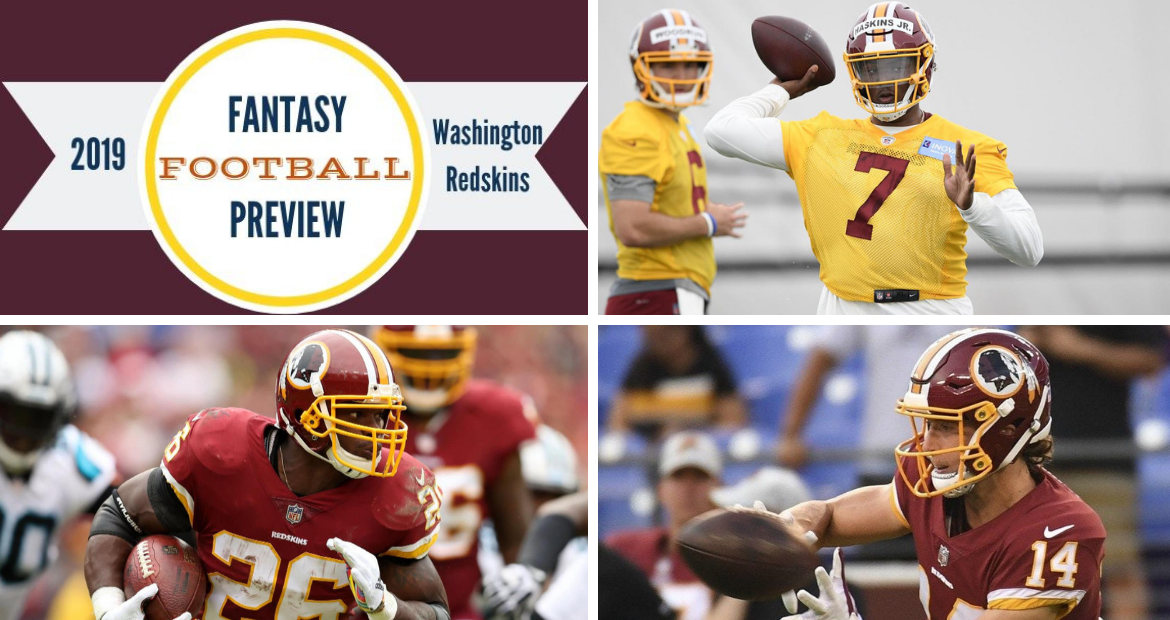
Fitz on Fantasy: 2019 Washington Redskins Buying Guide
With the preseason nearing, TFG fantasy expert Pat Fitzmaurice is breaking down the prospects for all 32 teams. Click here for a running list of teams, and check back often as teams are added on almost daily basis.
Ooh, so we have to talk about these guys, huh?
The Redskins haven’t won a playoff game since 2006 and haven’t made it past the divisional round since their last championship run in 1992. In the 20 years since Daniel Snyder bought the team, the Redskins have a regular-season winning percentage of .436 and have finished in the bottom half of the NFC East 15 times.
It seems unfair that someone as charming and kindly as Snyder should have to endure such disappointment. But hey, mo’ money, mo’ problems … amirite?
A nice haul in this year’s draft is reason for optimism among the D.C. downtrodden. The highlight: Washington was able to get one of the top quarterbacks without trading up from the middle of the first round, thanks largely to the bumbling of Dave Gettleman, GM of the division-rival Giants. That was fun.
But the 2019 outlook is pretty bleak. For fantasy purposes, this team is infertile bordering on radioactive. But let’s put on our hazmat suits and wade into the morass, shall we?
Derrius Guice was a sight to behold at LSU, displaying a pro-ready blend of speed, balance, power and elusiveness. Then he sat down at the NFL poker table and was immediately dealt 7-2 offsuit. He tore his ACL last August, then got an infection and required additional surgeries. The recovery has been slow, but he’s expected to be ready to go for training camp. This could be the takeoff year for Guice, but he’ll be trying to taxi on a short runway.
The Redskins signed Adrian Peterson to a cheap one-year deal last August after Guice went down, and he gave them 1,042 rushing yards and eight total touchdowns, good for an RB18 finish in half-PPR formats. Peterson re-signed in March, agreeing to a modest two-year deal. It may be hard for us to get a read on whether the team will defer to the veteran for much of the season or be willing to cast aside the 34-year-old Peterson in much the same way the Saints did two years ago when they realized that Alvin Kamara had to play.
Guice isn’t expensive right now, but this doesn’t seem like the right time to buy in light of the lingering injury concerns, the presence of Peterson and the gloomy overall outlook for the Washington offense. As Brooklyn Dodgers fans used to say: Wait till next year.
Peterson isn’t a guy you’d planto get in a fantasy draft, but the value could be pretty good if drafters remain cold on him yet Washington names him the starter.
Chris Thompson breaks more easily than a toy at the bottom of a cereal box. He made a splash two years ago when circumstances dictated that he be used in more than just a third-down role, but a broken fibula ended prematurely ended the most fantasy-relevant season of his career to date. He was back in a third-down role last year, and that’s where he’ll remain now that there are multiple early-down RBs in front of him. People who remember Thompson’s 2017 success might take him late in drafts, but there are better darts to be thrown.
The wild card here is rookie Bryce Love, a fourth-round pick from Stanford. Love tore his ACL in Stanford’s last regular-season games, and there was concern before the draft that he was still experiencing stiffness in the knee. Love went berserk in 2017, rushing for 2,118 yards and 19 TDs, but he was far less effective as a senior. The injury outlook is foggy, and there are a lot of bodies ahead of him on the depth chart, memories of that near-Heisman-worthy ’17 campaign still linger. Don’t draft him in 2019, but don’t forget him either.
My favorite college prospect evaluator, Thor Nystrom (@thorku), had Dwayne Haskins ranked ahead of Kyler Murray this year. Haskins profiles as an old-school pocket quarterback: big frame, big arm, not very mobile. He put up circus numbers in his one year as the Ohio State starter, completing 70% of his throws for 4,831 yards, with 50 TD passes and eight interceptions. The Buckeyes had an uncharacteristically soft defense last year, so OSU needed Haskins to help them win shootouts, and he did. There was a 52-51 escape act against Maryland where Haskins threw for 405 yards and three TDs, a 62-39 pasting of archrival Michigan in which he threw for 396 yards and six TDs, and a 28-23 Rose Bowl win in which he had 251 yards and three TDs against a nasty Washington defense.
The future is bright for Haskins. The present … not so much. There will be the inevitable rookie mistakes, of course. His lack of running ability will keep a tight lid on his fantasy potential, as will the mediocre group of pass catchers he’ll be working with. Also, Washington played at the league’s slowest pace last year. Watching the Redskins run their offense was like watching your grandparents try to hook up their new computer without help.
Oh, and there’s one other potential problem for Haskins. Stud left tackle Trent Williams skipped the team’s mandatory June minicamp because he’s angry with the medical staff, and he reportedly wants out of Washington. If the Redskins can’t get him back in the fold, they may have to plug in Ereck Flowers at left tackle. Flowers, drafted ninth overall by the Giants in 2015, has been an unmitigated bust to date, pass-blocking like a Spanish matador. The last thing the D.C. faithful want to see is Flowers trying to protect their rookie quarterback’s blind side.
Trey Quinn might be the most interesting fantasy commodity on the team. Drafted in the seventh round out of SMU last year, Quinn played in three games and had nine catches for 75 yards and a touchdown. He’s being talked up and seems ticketed for the slot role.
Ohio State’s leading receiver last season was Parris Campbell, who’s now with the Colts. Campbell’s average depth of target last year was just 4.5 yards, and maybe Haskins will use Quinn the way he used Campbell last year, peppering him with short throws. It’s hard to see Quinn averaging much more than 10 yards per catch or scoring a lot of touchdowns, but it’s not hard at all to see him catching 70-75 passes, which would make him a particularly useful asset in PPR leagues.
Paul Richardson’s 4.4 speed has kept some people interested in him, but he’s had only one decent season over his five-year career, and he’s been plagued by injuries. Richardson signed a five-year, $40 million deal in early 2018, then caught 20 passes for 262 yards and two TDs before sustaining an injury to the AC joint in his shoulder that wiped out half his season. Oh, and he still hasn’t been cleared to return. No thanks.
A first-round pick out of TCU in 2016, Josh Doctson has failed to ignite, and Washington declined to pick up his fifth-year option for 2020. He just hasn’t shown us enough highlight-reel stuff to hold our attention, If Doctson and DeVante Parker ever end up on the same roster, we’ll see a one-day usage record for that double Spider-Man meme on Twitter.
Rookies Terry McLaurin (third round) and Kelvin Harmon (sixth round) aren’t draftable in most leagues but could quickly climb a rickety depth chart. McLaurin had only 35 receptions for the Buckeyes last year but averaged 20 yards per catch and scored 11 TDs. He has 4.35 speed and will always be active on gamedays because he’s so good on special teams. Harmon slid in the draft because of ordinary athleticism but had back-to-back 1,000-yard seasons to end his college career at N.C. State.
Jordan Reed is the tight end of choice for the sort of people who still drive without a seat belt and don’t mind taking a chance on expired lunch meat. With his extensive injury history, Reed has always been a risky wager, but the upside was so appealing because he usually balled out whenever he was fit. But over the last two years, Reed has exceeded 60 yards three times in 19 games and has scored only four touchdowns. He’ll be 29 when the new season begins. Is he still the same explosive athlete he was in his mid-20s? The injury risk is still there, but the potential payoff might not be what it once was.
Vernon Davis, meanwhile, is aging quite gracefully. Davis, 35, has somehow averaged 14.9 yards per catch over the last two years. He won’t be drafted often, but he’ll find his way onto rosters if (read: when) Reed gets hurt
| PLAYER | FITZ RANK | ECR | ADP | Advice |
| Dwayne Haskins | QB30 | QB32 | QB27 | ETA: 2022 |
| Derrius Guice | RB37 | RB31 | RB29 | Wait a year |
| Adrian Peterson | RB44 | RB46 | RB52 | Unsexy value |
| Trey Quinn | WR61 | WR89 | WR85 | Buy late |
| Jordan Reed | TE18 | TE16 | TE21 | Too dicey |
ADP = Average Draft Position ECR = Expert Consensus Ranking (based on half-PPR scoring)



